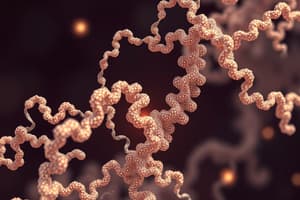Podcast
Questions and Answers
What are educators referring to when they define concepts?
What are educators referring to when they define concepts?
- Perceived regularities in events or objects (correct)
- Historical definitions of knowledge
- Statistical data regarding student performance
- Broad theories about education
Which of the following is NOT specified as one of the types of concepts in biochemical maps?
Which of the following is NOT specified as one of the types of concepts in biochemical maps?
- Compounds
- Theories (correct)
- Abstractions
- Processes
In a biochemical map, how is the relative importance of concepts indicated?
In a biochemical map, how is the relative importance of concepts indicated?
- By the number of connections made
- By the size of the text (correct)
- By the type of line used
- By the color of the boxes
What role do the lines drawn between concept boxes serve in a biochemical map?
What role do the lines drawn between concept boxes serve in a biochemical map?
What indicates the direction of the relationship between two concepts in biochemical maps?
What indicates the direction of the relationship between two concepts in biochemical maps?
Which of the following amino acids is classified as nonpolar?
Which of the following amino acids is classified as nonpolar?
What is the pK1 value for Glycine?
What is the pK1 value for Glycine?
Which of the following amino acids has a side chain that contains a sulfur atom?
Which of the following amino acids has a side chain that contains a sulfur atom?
Which amino acid is most likely to be found in a hydrophobic environment?
Which amino acid is most likely to be found in a hydrophobic environment?
Which amino acid is characterized by having a ring structure in its side chain?
Which amino acid is characterized by having a ring structure in its side chain?
Which amino acid has both a nonpolar and an aromatic side chain?
Which amino acid has both a nonpolar and an aromatic side chain?
Considering their chemical properties, which amino acid is charged at physiological pH (around 7.4)?
Considering their chemical properties, which amino acid is charged at physiological pH (around 7.4)?
Which of the following amino acids has the highest pK2 value?
Which of the following amino acids has the highest pK2 value?
What is the main purpose of Lippincott’s Illustrated Reviews: Biochemistry?
What is the main purpose of Lippincott’s Illustrated Reviews: Biochemistry?
Which feature of Lippincott’s Illustrated Reviews is highlighted as particularly valuable for learning?
Which feature of Lippincott’s Illustrated Reviews is highlighted as particularly valuable for learning?
For how many years has Lippincott’s Illustrated Reviews been a trusted resource?
For how many years has Lippincott’s Illustrated Reviews been a trusted resource?
What format does Lippincott’s Illustrated Reviews use to present information?
What format does Lippincott’s Illustrated Reviews use to present information?
Who is the series editor of Lippincott’s Illustrated Reviews: Biochemistry?
Who is the series editor of Lippincott’s Illustrated Reviews: Biochemistry?
What is emphasized in Lippincott’s Illustrated Reviews regarding coursework preparation?
What is emphasized in Lippincott’s Illustrated Reviews regarding coursework preparation?
Which statement reflects a common use of Lippincott’s Illustrated Reviews by students?
Which statement reflects a common use of Lippincott’s Illustrated Reviews by students?
What unique aspect of Lippincott’s Illustrated Reviews has been praised by faculty and students?
What unique aspect of Lippincott’s Illustrated Reviews has been praised by faculty and students?
What does the Henderson-Hasselbalch equation relate to?
What does the Henderson-Hasselbalch equation relate to?
In the context of weak acids, what does Ka represent?
In the context of weak acids, what does Ka represent?
What is the pKa of the weak acid represented by HA when Ka is 4.8?
What is the pKa of the weak acid represented by HA when Ka is 4.8?
Which form represents the conjugate base of the weak acid, acetic acid (HA)?
Which form represents the conjugate base of the weak acid, acetic acid (HA)?
What happens when a weak acid is added to water?
What happens when a weak acid is added to water?
Which statement about a weak acid's conjugate base is true?
Which statement about a weak acid's conjugate base is true?
What is indicated by a larger Ka value for a weak acid?
What is indicated by a larger Ka value for a weak acid?
Which of the following describes a buffer solution involving a weak acid and its conjugate base?
Which of the following describes a buffer solution involving a weak acid and its conjugate base?
What is the one-letter symbol for asparagine?
What is the one-letter symbol for asparagine?
Which amino acid has the one-letter symbol 'W'?
Which amino acid has the one-letter symbol 'W'?
What is the three-letter abbreviation for glutamate?
What is the three-letter abbreviation for glutamate?
What letter is assigned to glycine based on its commonality?
What letter is assigned to glycine based on its commonality?
Which amino acid corresponds with the letter 'F'?
Which amino acid corresponds with the letter 'F'?
Which of the following amino acids shares the one-letter symbol 'D'?
Which of the following amino acids shares the one-letter symbol 'D'?
What is the one-letter symbol for lysine?
What is the one-letter symbol for lysine?
What classification does the symbol 'X' represent?
What classification does the symbol 'X' represent?
Flashcards are hidden until you start studying
Study Notes
Amino Acids
- Twenty amino acids are commonly found in proteins.
- The amino acids can be classified based on the charge and polarity of their side chains.
- Each amino acid has a three-letter abbreviation and a one-letter symbol.
- The one-letter symbols are determined by:
- Unique first letter
- Most commonly occurring amino acids have priority
- Similar sounding names
Henderson-Hasselbalch Equation
- This equation describes the relationship between the pH of a solution and the concentration of a weak acid and its conjugate base.
- The dissociation constant of an acid (Ka) is defined as the ratio of the product of the concentrations of hydrogen ions and the conjugate base to the concentration of the acid.
- The stronger the acid, the larger the Ka.
Concepts
- Concepts are perceived regularities in events or objects, including abstractions (for example, free energy), processes (for example, oxidative phosphorylation), and compounds (for example, glucose 6-phosphate).
- Concept boxes are prioritized with the central idea positioned at the top of the page.
- The size of the type indicates the relative importance of each idea.
- Lines are drawn between concept boxes to show which are related.
- The label on the line defines the relationship between two concepts, so that it reads as a valid statement, that is, the connection creates meaning.
- The lines with arrowheads indicate in which direction the connection should be read.
Studying That Suits You
Use AI to generate personalized quizzes and flashcards to suit your learning preferences.




